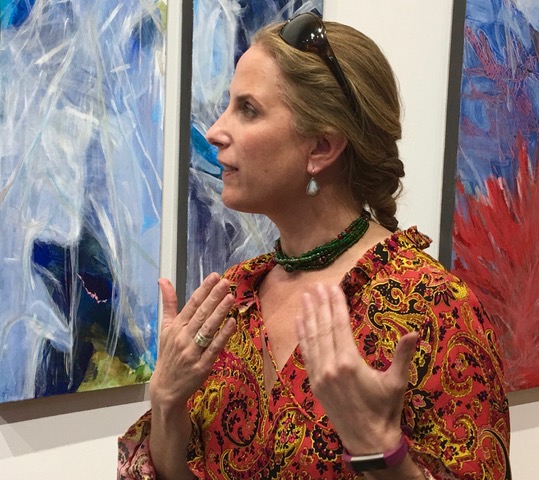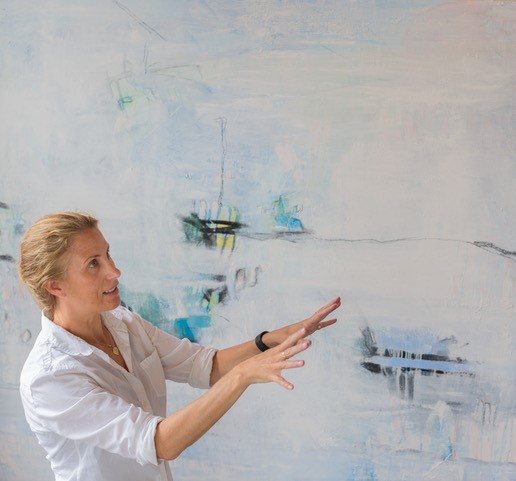Katherine Downey Miller Painter
How important is your environment to your past and current work?
Growing up in New England, the weather and change of seasons became very important to my past and present work. I grew up with a sky light above my bed, enabling me to see the seasons change, see what it was like during a thunderstorm or what happens when rain pelts down. It’s very important to me to be near the ocean. I don’t have to be around it all the time, but just to know it is there and I can access it. It gives me a sense of openness of mind. My painting studio is located in SOWA, the Arts district in Boston in the South End. I’m surrounded by galleries and activity and yet can shut my door and focus on my work. I have great light in my studio which is very important. I can hear seagulls near my studio. I like to go outside and sketch and paint. I bring all my information into the studio and work from there.

Collossal, Acrylic and Mixed media on watercolor paper, 50”x 50“
How do you deconstruct your work to abstract landscapes?
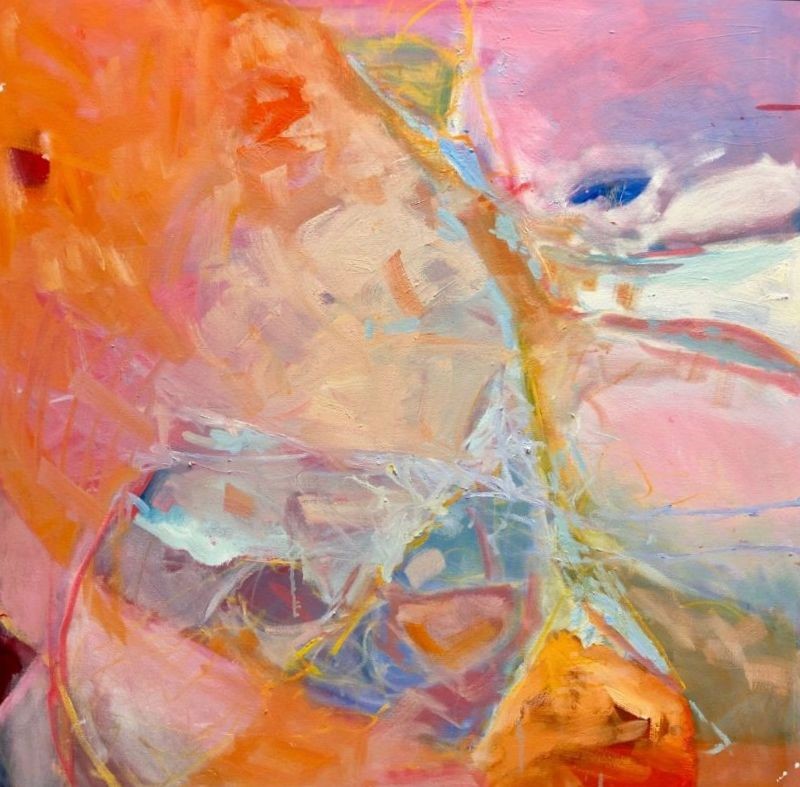
Salmon, Oil on canvas, 36″ x 36″
I deconstruct my work by starting with some kind of reference to the land or natural elements. It could be literal or emotional. As I build the painting through composition and gestural movement, I turn my painting around, and paint from all sides until the painting works each way, in terms of the visual language. Each time I turn the painting, the language changes and becomes fresh.
In your opinion discuss the importance of art to record time and place.
I think art is important in recording time and place because it is visual. Art can be a visual representation of place, of an important place to the artist. Art can also be place coming from emotion. Time is more difficult but can be shown through many ways. Representationally, it can be shown by how many different ways light hits a tree, or by showing a whole apple, then different bites taken out of the apple. In a way a visual story with no words. Abstractly, time and place can be shown through mood or color.
How did you see your movement from representational to abstract.
My undergraduate degree is in painting from Skidmore College and my MFA from the School of Visual Arts in NYC. I think as a young artist I was drawn to a kind of representation. I was always a loose painter. My power has always been shown through my brushstrokes. My MFA is in Illustration, so I am drawn to the tangible, but I am also drawn to atmosphere and the intangible.

Santa Fe, oil on canvas, 24″ x 24″
I think it’s a natural progression and evolution to go from representational to abstract. The easiest way for me to access this is landscape to abstraction. I think nature is the best teacher. It’s all me, my brushstrokes and imagery are just looser, yet based in natural, organic structure.

Into the Deep, oil on canvas, 36” x 36”
You show your work installed. Can you explain the value of this presentation method?
The value of showing my work installed is that it gives me a deadline and makes me work towards it. I find I work better under deadline, whereas, if I don’t have a deadline, things are a bit wishy washy. Presentation is very important because it makes one get organized with the artist statement and other documents. It’s important for me to get my work seen because I do want to sell it. It does little good sitting in my studio. Installing my work allows me to finish a chapter as well and enables me to work on new bodies of work and new ideas.
You use both water colour and oil in your work when do you use one rather than and other.

Flow 1, Acrylic on canvas, 20” x 20”
I teach watercolor, but don’t necessarily use it. I use Golden High Flow Acrylic paint on prepared surface, that enables the paint to react like watercolor. As a watercolorist, I love watercolor blooms, but the colour isn’t vivid enough for me, so I figured out this other way to have my acrylics look like watercolor. I love the lightness of feeling of water media paints, but I love the richness of oils. They are like butter. So, it depends on what I am painting and what mood I’m in, which media I choose to work in at that moment.

Red Rocks, oil on canvas, 36“ x 36“
Your Dog Portraits:
How patient are dogs and yourself to paint?
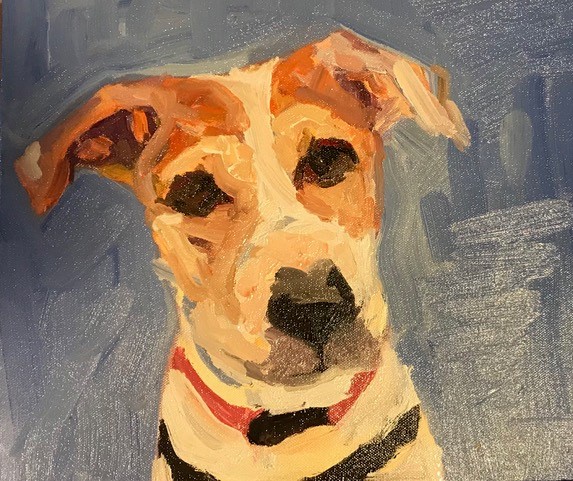
Rustler, oil on canvas, 11“ x 14”
When dogs are sleeping, they are patient! I work from photographs and enlarge them.
What techniques do you use?
I use brushwork as description of form in oil, watercolor and acrylics. I don’t know what technique I would call it except shaping with my brushes.
How do you manage to capture each dog’s personality?
I manage to capture each dog’s personality because I do a photoshoot with the owner and their dog in a place that is special to them. Meeting the dog makes it not such a disconnect for me when I paint. I can sense the personality of the dog through the meeting. I create a series of sketches which are then reviewed by the client.

Lolita, oil on canvas, 11” X 14”
Take a commission and explain why it has been so special?
My dog commissions have been so successful because of the time I take to paint them and the individual attention I give to my clients. I share my working sketches with them so they can be part of creative process and decision making. When I start on the painting, I have the composition down in the sketches, so I am prepared to start painting. I usually work from multiple photographs as well as meet the dog, so I really feel I get a feeling for their personality.
For example, in this portrait of Jesse, painted in oil, size 12”x 12”, I feel that I captured her loving gaze. She was quite elderly at the time and I think the work expresses the wisdom she gained in her years.
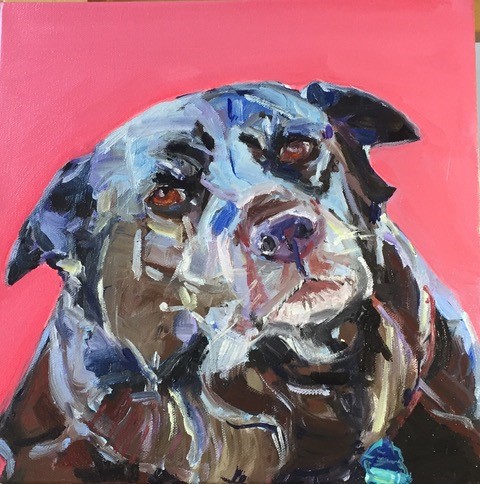
Jesse, oil on canvas, 12” x 12”
Discuss background in the dog images.
Sometimes, I just do a plain background in a punchy color that complements the color of the dog and highlights their aura. Other times, I include some landscape or a place that is important to the dog and the owner. I always try to meet the client’s wishes but sometimes need to temper them with what I know will work.
Discuss the philanthropic aspect of this aspect of your work.
I donate a lot of work to school auctions, medical groups and the MSPCA / Angell Memorial. Who wouldn’t want to buy or win a dog portrait that goes towards a good cause? I believe in the causes I support and it doesn’t hurt to also get my name out.
Can you explain the relationships between your visits to the New England Aquarium, your lifetime bound with the sea and your latest body of work?

Lake, Acrylic and mixed media on canvas, 6’ x 6’
I originally went to the New England Aquarium to look for glow in the dark fish and fish with bio luminosity, which I am fascinated with because it is a natural occurrence in nature. When I got there, I was intrigued by the color blue. It was dirty aquarium water, but in the pictures, it looked like gorgeous azure blue, all different tones. This current body of work was sparked by the concept of bio luminosity and remembrances of growing up, visiting the ocean, swimming, fireflies and phosphorescence – like stars falling to the ground. When I went to the aquarium, I thought what I would be looking for was bio luminosity. What I came away with were ideas about water, undersea life, the many different colors, etc. So, this current body of work became even more about the ocean and water. I’ve always thought of the ocean as the great vast unknown, a source of life, never-ending. And we don’t treat it well, so I wanted to call attention to its beauty and energy. As a painter, I’ve always been intrigued by light. Imagine looking up through the water and seeing a shaft of light shining through. Just beautiful. So, there is a direct connection between my childhood remembrances and my current feelings and emotions towards the ocean and the color blue.
Contact details:
Katherine Downey Miller
kdowneymiller@gmail.com
Deborah Blakeley, Melbourne, Australia
Interview by Deborah Blakeley, May 2019
Think a colleague or friend could benefit from this interview?
Knowledge is one of the biggest assets in any business. So why not forward this on to your friends and colleagues so they too can start taking advantage of the insightful information the artist has given?
Other artists you may be interested in:


